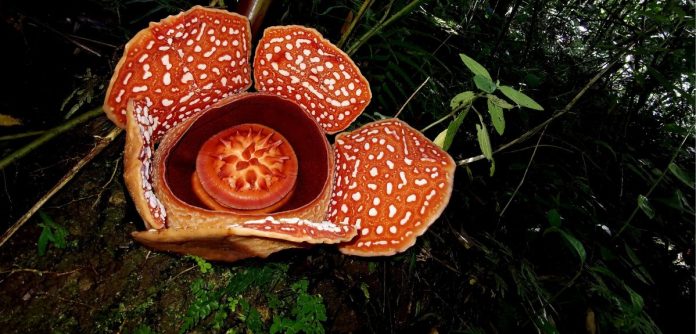An international group of scientists, has issued an urgent call for coordinated action to save the iconic genus Rafflesia, which contains the world’s largest flowers.
This follows a new study published this week which found that most of the 42 species are severely threatened, yet just one of these is listed in the International Union for Conservation of Nature (IUCN)’s Red List of Threatened Species. Furthermore, over two thirds (67%) of the plants’ habitats are unprotected and at risk of destruction.
Rafflesia, one of the greatest botanical enigmas, has aroused curiosity among scientists for centuries. The plant is a parasite that infects tropical vines in jungles across Southeast Asia (Brunei, Indonesia, Malaysia, the Philippines, and Thailand). For most of its lifecycle, Rafflesia is hidden from sight, existing as a system of thread-like filaments that invades its host.
At unpredictable intervals, the parasite produces a cabbage-like bud that breaks through the vine’s bark and eventually forms a giant, five-lobed flower, up to a metre across. This produces a foul scent of rotting meat to attract pollinating flies, earning it the alternative name ‘corpse flower.’
With such an elusive lifecycle, Rafflesia remains poorly understood, and new species are still being recorded. To better understand the vulnerability of these unique plants, a group of scientists established the first coordinated global network to assess the threats facing Rafflesia.
The results of the study found that all 42 Rafflesia species are under threat: based on the criteria used by the IUCN, the scientists classified 25 as ‘Critically Endangered’, 15 as ‘Endangered’, and two as ‘Vulnerable’. Furthermore, over two-thirds (67%) are unprotected by regional or national conservation strategies.
Rafflesia species often have highly restricted distributions, making them particularly vulnerable to habitat destruction. The study found that many of the remaining populations contain only a few individuals located in unprotected areas at critical risk of conversion for agriculture. Since attempts to propagate Rafflesia in botanic gardens have had limited success so far, this makes habitat conservation an urgent priority.
To address these threats, the researchers recommend that all Rafflesia species are immediately added to the IUCN Red List of Threatened Species. Currently just one is listed: Rafflesia magnifica.







